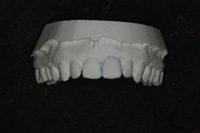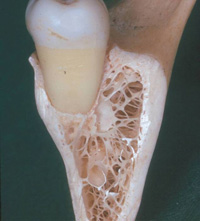Every game in life contains two important components: opportunities and challenges. Dentistry is a game, and every day, like a great sports team, you play to win. The keys to winning unfold through leveraging every opportunity and effectively managing all challenges.
Let’s begin with the upside. Endless opportunities provide today’s dentistry teams with virtually unlimited possibilities. For instance, the market for restorative and aesthetic dentistry now expands beyond previously known bounds. Many dentists now experience new levels of income and are able to create the free time to enjoy the benefits of that income. Also, dentists build motivated teams that rival their own motivation and standard of care for patients. This is not study club talk. These results are real and tangible.
When I share this reality and this “have-it-all” mindset, dentists always respond,
“Yeah, right.”
 |
| Photograph by Brian C. Green |
Why should a doctor just down the street turn in double or triple the production of your practice? After all, the other doctor’s capabilities and experience do not exceed yours. He or she does not have a better team or a larger patient base from which to draw. I find that most practices operate at 30% to 50% of their capacity and capability. Yes, only 30% to 50%! I know this to be true because of the results that can be achieved in terms of practice performance when we tackle one of the primary challenges that impedes profitability: managing patient fear. This sounds simple and easy. It is easy when you have a system and methodology to address patient fear with every patient and as a whole team.
Before we delve into the applied action systems to eliminate the fear barrier that blocks case acceptance, higher income, and freedom, I want to highlight an important issue that will help you manage your entire practice. There are hundreds of challenges in managing a dental practice. You can spend a lifetime trying to fix them, and earlier in my coaching career, that’s how I expended my energy too. Most challenges are symptoms of a deeper problem. If you spend the time tracing the difficulties to the source issue that precedes the appearance of the problem, then you get closer to its cause. There are only a handful of root causes for all the challenges that impede maxing out productivity in every practice. One primary cause is the failure to manage patient fear, and another principal cause is the inability to make and keep agreements. For the purposes of this article, we shall focus on patient fear.
TRACING PROBLEMS TO THE SOURCE
To highlight the point about tracing problems to the source, I will share a story about the challenge facility managers faced at the Lincoln Memorial in Washington, DC. Every day throngs of visitors pass through the Lincoln Memorial. Over a period of time, birds congregated on the ledge of the roof, and every day the birds anointed the walls with unsightly bird droppings. As part of its daily drill the maintenance crew pressure-washed the sides of the monument, restoring its pristine appearance. Management finally decided to find a way to get rid of the birds, and hired a bird expert. The ornithological authority examined the situation, revealing that the problem was with insects rather than birds. The insects attracted the birds, which left the droppings. So, management brought in an insect specialist, who found the problem was not with insects, either. The problem was moisture—that of standing water, which attracted insects. The monument’s flat roof created poor, if any, drainage. To top it off, the daily pressure washing only exacerbated the problem of lingering moisture. By locating the original cause of the problem, facility managers tracked it to the source, put in better drainage, and stopped “washing” the symptom. Now maintenance crews pass their time beautifying the grounds rather than “putting out the fire.”
Where fires burn, fuel, a spark, and oxygen coexist. Let’s knock out the patient fear fire that burns a seemingly uncontrollable hole in your wallet and frustrates you and your team. Our practice development strategies operate by eliminating what we call “blind spots.” Basic things about your patients, your team, and sometimes yourself constitute blind spots, and if you knew what those blinds spots potentially cost you, you would take a different approach in managing them. One of the most common blind spots comes from failing to manage patient fear. Not only must you surface patient fears, you must locate the deep-rooted fear that drives your patients into noncompliance with your recommendations and practice policies. These deep-rooted fears manifest in both conscious and subconscious realms.
Almost always, patients thinly mask conscious fears with excuses. When was the last time you heard, “I am really scared of getting that procedure today. Could you help me overcome my fears so that I can come in and get it done?” You probably haven’t heard that because it is far less confronting for a patient to offer up excuses including illnesses, deaths in the family, or acts of God. The challenge of confronting excuses that tug so strongly at your heartstrings causes most clinicians to let them slide. Our study shows that only 15% of all phone calls to change or cancel appointments contain valid and real reasons for doing so. Subconscious fears rooted in issues of money, pain, and time appear to be real, and subsequently, get between you and case acceptance.
Sports teams spend tons of money and time and hire the best experts to scout their opponents so they can create all possibilities of winning. I am by no means saying that your patient relationships need to feel as adversarial as that of 2 teams battling it out on the field. Rather, it is you and your team in a battle to defeat your patients’ fears. Understanding what goes on behind the scenes in the psyche of your patients allows you to help your patients get all the care they require. Let’s face it, more often than not, patients’ fears have beaten dental teams for years, and patients fail to receive proper care. Then patients wonder why they experience pain caused by neglected dental work and end up spending more money than if you fixed the problem when it was first diagnosed.
TYPES OF PATIENT FEAR
Patient fear can be broken down into 4 subcategories:
(1) fear of shame/embarrassment/looking bad
(2) fear of pain
(3) fear of cost
(4) fear of the unknown.
One of our guiding practice management philosophies is this: take time and good care on the front end, and the back end takes care of itself. In this article we shall focus on overcoming patient fear in your marketing, initial phone call, and the patient’s first visit. This upfront care creates a huge impact on your practice because you break down the walls of patient fear, gain the patient’s trust, and swiftly cultivate the patient’s listening ability so they can actually hear you and not the normal, Charlie Brown-teacher sound of “waa-waa-wa-wa-wa-wa.”
OVERCOMING PATIENT FEAR IN YOUR MARKETING
There are 4 primary components to effective marketing messages:
(1) The message must solve an urgent problem.
(2) The message needs to state a unique promise.
(3) You must offer unquestionable proof.
(4) You must submit a user-friendly proposition.
Combining the makeup of a powerful marketing message pointed directly at overcoming patient fears quickly turns into a key for achieving high response rates. Here are some copy elements:
Solving an Urgent Problem
“Are you afraid of the dentist? Not any more!” This addresses a patient’s fear of pain.
“Has it been a while since you have been to the dentist?” Here you address fear of shame/embarrassment/looking bad and offer exoneration.
Making a Unique Promise
We take the time to get to know you and treat you as an individual. We understand that you may have experienced challenging dental visits in the past. We listen to what is most important to you and make a sincere effort to deliver it with each visit. We do not judge you if it has been a while since you have seen a dentist. We are here to help you understand what it takes to have a healthy smile. It is completely up to you if you want us to provide treatment that is less than our optimal recommendations. You are always in control. We take the time to explain everything you need to know about your treatment so you can make an educated decision regarding your care. We will make you fully aware of your investment before any treatment is done. Once you tell us it is okay to proceed, the doctor and hygienist will explain what will happen before every step of the treatment, allowing you to remain in control. The whole time, from determining the health of your smile, to the presentation of a budget that works for you, to the actual treatment, you enjoy the comfort of always knowing what will happen before it happens.
Offering Unquestionable Proof
Make a plan to interview your most phobic patients that you successfully turned around. Ask them before-and-after, open-ended questions using the 4 subcategories of fear. “Before you came to us, please share with me what your fears and concerns were regarding… and what is your experience now?” Ask for permission to use their comments and write them up as your undeniable proof.
Making a User-Friendly Proposition
This depends on the position of your practice. Insurance and price-sensitive practices benefit from offering a front-end deal. Those practices that deliver quality and service, offer a no-obligation, get-acquainted tour, and conduct an interview to see if the practice and the doctor offer a good fit with the patient clearly benefit from this approach.
OVERCOMING PATIENT FEAR
You probably spend a lot of money on marketing. So, it is vital to ensure that at least 90% of the initial phone calls result in the scheduling of new patients and ensuring those appointments are kept. My experience of the average dental office reveals that the rate of scheduling new patients runs a dismal 65%.
There are 2 theories regarding the amount of information gathered and time allowed with patients on the first call. The theories contrast in 2 simple questions: Would you rather put someone in your schedule without creating a bond and take the chance of a cancellation or no-show? Or would you rather make the effort to establish solid communication, which eases a patient’s fears, because you offered time for a clear dialogue exchange at the first point of contact? I have found the latter approach to work very effectively in clinics and highend specialty offices. I have also found that patients are 2 or 3 times more apt to show up if you gather a large amount of personal information and communicate. Patients develop an emotional attachment based on trust and respect when they feel like they matter. A key element in this bond unfolds as you eliminate the patient’s fear of the unknown.
How do you get your scheduling numbers up to an acceptable level? Apply these 4 steps:
Step 1. Designate a new-patient coordinator for booking new clients. This individual may double as your team leader.
Step 2. Designate a quiet atmosphere in which your coordinator takes the calls. The doctor’s office would be acceptable if not in use.
Step 3. Custom design a new-patient intake form to use in the intake phone call that asks for the vital information to be gathered and poses reaction-sensitive questions. The phone call should also address any fears, concerns, or questions with compassion and an attentive ear while allowing the prospective patient ample time to be heard.
Step 4. Make notes and communicate a patient’s vitals and fears to the doctor and team members during morning meetings, ensuring that everyone is on the same page.
When your first point of contact answers the patient’s phone call, make it a rule to ask the prospective patient’s name immediately. Have your contact person explain why your office is unique because of your attentive, interactive style. Then ask permission to begin patient registration, promising it only takes a few brief minutes. The use of the key word registration creates a sense of commitment. You dramatically eliminate initial appointment no-shows simply by using your call and the quality of communication within it to show the commitment inherent in every aspect of your practice.
Through a high-quality initial interaction, prospective patients can see, hear, and sense the energy of your office. At this point the patient generally feels more inspired by the attentiveness and sufficiently connected enough to trust your office. And they show up!
Naturally, patients still feel skeptical and fearful when they enter your office. Fearful patients display a sharp hypersensitivity toward anything that overwhelms their senses. Their first impression comes from the physical presence of your reception area. Clutter, an outdated décor, or old magazines trigger fearful minds into inconsolable overload. A team member walking out from behind the desk in your reception area with a warm smile and offering a light handshake supports a feeling of trust and relaxes those initially tense responses. Again, a team member immediately communicating to the patient what specifically will happen during the visit eliminates the primary and generally ignored fear—the fear of the unknown. When patients struggle with fear of the unknown, their minds embellish everything, making the situation feel worse than it is as a simple safety mechanism. If you are not clear on a patient’s condition or mind-set, then you would be well-advised to assume he or she is in a place that is far worse than it appears.
CONCLUSION
The clock continues to tick in your game of dentistry. Whether you are in the first or fourth quarter of the game, it is never too late to play big and enjoy all the fabulous benefits of being a dentist who created a patient-friendly practice. There’s room for lots of big winners in the game. Many of you can create your own destiny of winning the Super Bowl of dentistry.
Mr. Kadi transforms successful dentists into highly successful dentists—financially secure, professionally respected, and deeply satisfied with their practices and their lives. He innovated the Next Level methodology and is one of America’s leading dental practice developers. His 12 years of transforming and developing dental practices are captured in his newest book, Million Dollar Dentistry. He can be reached at (480) 361-9955, gary@nextlevelpractice.com, or by visiting nextlevelpractice.com.
To comment on this article, visit the discussion board at dentistrytoday.com.











